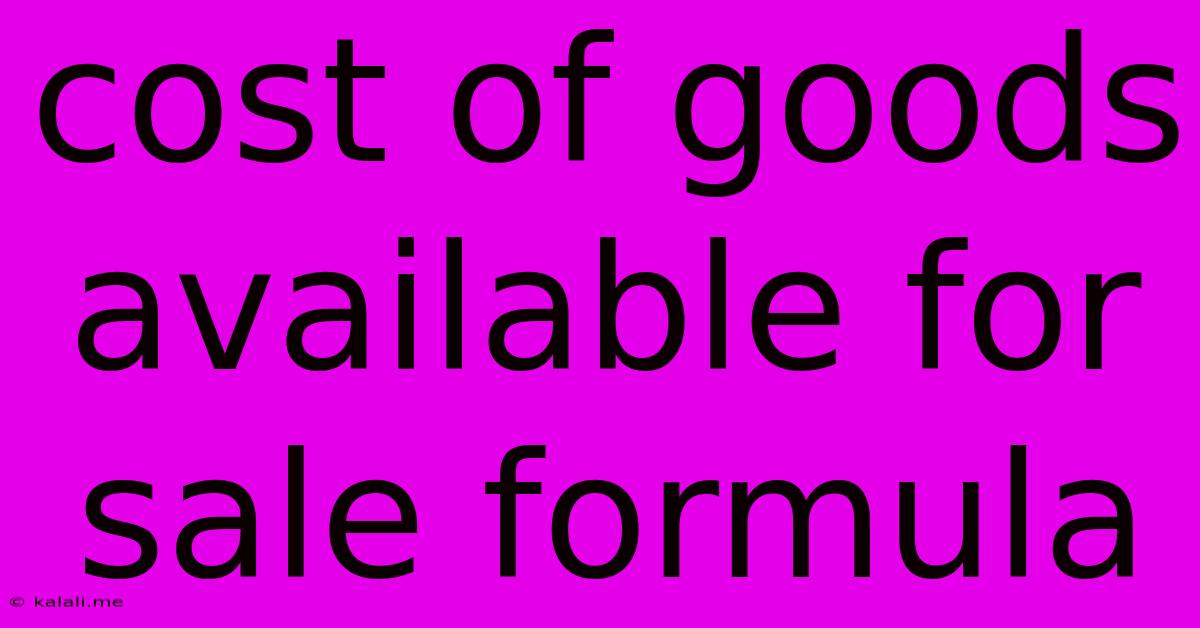Cost Of Goods Available For Sale Formula
Kalali
May 18, 2025 · 3 min read

Table of Contents
Understanding the Cost of Goods Available for Sale Formula: A Comprehensive Guide
Determining the cost of goods available for sale is a crucial step in calculating a company's gross profit and ultimately, its profitability. This formula helps businesses track the total cost of inventory ready for sale during a specific period. Understanding this calculation is vital for accurate financial reporting and effective inventory management. This guide will break down the cost of goods available for sale formula, explain its components, and provide examples to illustrate its application.
What is the Cost of Goods Available for Sale?
The cost of goods available for sale (COGAS) represents the total cost of all goods a business had available to sell during a given period. This includes both beginning inventory and purchases made during that period. Accurate calculation of COGAS is essential for determining the cost of goods sold (COGS) and ultimately, gross profit. This metric is especially important for businesses using the periodic inventory system.
The Cost of Goods Available for Sale Formula
The formula for calculating the cost of goods available for sale is straightforward:
Beginning Inventory + Purchases - Purchase Returns + Freight In = Cost of Goods Available for Sale
Let's break down each component:
- Beginning Inventory: This represents the value of inventory on hand at the start of the accounting period. It's the ending inventory from the previous period.
- Purchases: This includes all purchases of inventory made during the current accounting period. This figure should reflect the net cost after deducting any purchase discounts.
- Purchase Returns: These are goods returned to suppliers during the period. These returns reduce the total cost of purchases.
- Freight In: This represents the cost of shipping and transportation incurred to bring the inventory to the business's location. This is added to the cost of goods because it's a necessary expense to make the inventory sellable.
Example Calculation
Let's illustrate the formula with an example:
Imagine a business starts the year with a beginning inventory valued at $10,000. During the year, they purchase additional inventory worth $50,000. They return $2,000 worth of defective goods and incur $1,000 in freight charges.
Using the formula:
COGAS = $10,000 (Beginning Inventory) + $50,000 (Purchases) - $2,000 (Purchase Returns) + $1,000 (Freight In) = $59,000
Therefore, the cost of goods available for sale for this business is $59,000.
Using COGAS to Calculate Cost of Goods Sold (COGS)
Once you've determined the cost of goods available for sale, you can calculate the cost of goods sold. This is done by subtracting the ending inventory from the COGAS:
Cost of Goods Available for Sale - Ending Inventory = Cost of Goods Sold
For instance, if the ending inventory for the year in our example is $5,000, the cost of goods sold would be:
COGS = $59,000 (COGAS) - $5,000 (Ending Inventory) = $54,000
Importance of Accurate COGAS Calculation
Accurate calculation of COGAS is vital for several reasons:
- Accurate Financial Reporting: Correct COGAS ensures that financial statements, particularly the income statement, are accurate and reliable.
- Inventory Management: Tracking COGAS helps businesses monitor inventory levels and identify potential issues with stock management.
- Profitability Analysis: COGAS is a crucial component in calculating gross profit and ultimately, net profit, enabling businesses to understand their profitability.
- Tax Purposes: Accurate COGAS calculation is essential for accurate tax reporting.
By understanding and correctly applying the cost of goods available for sale formula, businesses can gain valuable insights into their inventory management and overall financial performance. Regularly reviewing this calculation helps maintain efficient operations and informed decision-making.
Latest Posts
Latest Posts
-
How Long Does A Toilet Last
Jun 01, 2025
-
App For Windows 11 Internet Connection Monitor In Taskbar
Jun 01, 2025
-
How To Get Cat Urine Out Of Hardwood Floors
Jun 01, 2025
-
Do With This What You Will
Jun 01, 2025
-
Can I Call Myself Fullstack Software Engineer Intern
Jun 01, 2025
Related Post
Thank you for visiting our website which covers about Cost Of Goods Available For Sale Formula . We hope the information provided has been useful to you. Feel free to contact us if you have any questions or need further assistance. See you next time and don't miss to bookmark.